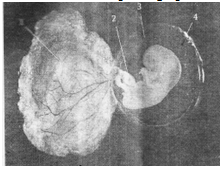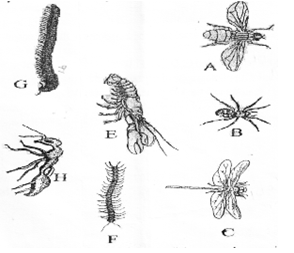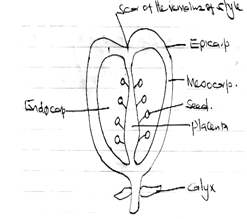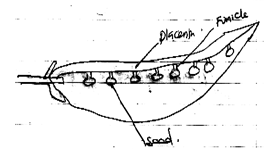INSTRUCTION TO CANDIDATES
- You are required to spend the first 15 minutes of the 13/4hours allowed for this paper reading the whole paper carefully before commencing your work..
- You are provided with a specimen labelled R and S
- Draw and lebel vertical section of specimen R (5mks)
- Classify specimen R (1mk)
-
- Squeeze the juice from specimen R into a small beaker. Using the reagents provided, test for the food substances in the juice. Record the food substances procedure, observation and conclusion in the table below (6mks)
Food substance
Procedure
Observation
Conclusion
- Name the deficiency disease in humans that would result from lack of fruits in the diet (1mk)
- Squeeze the juice from specimen R into a small beaker. Using the reagents provided, test for the food substances in the juice. Record the food substances procedure, observation and conclusion in the table below (6mks)
- Break open the case, make a labelled drawing of one of the halves with same structures inside (4mks)
- Name the type of placentation in specimen (2mks)
- R
- S
-
- Name the type of dispersal of specimen R (1mk)
- How is the specimen adapted for dispersal by the agent named above? (1mk)
- Below is a photograph of a developing human foetus. Examine the photograph
- Name the parts labelled 1,2,3 and 4 (4mks)
- State one function in each case of the structure labelled 3 and 4 (2mks)
-
- Name three substances that are allowed to pass through structure labelled 1 from the mother’s blood to the foetus (3mks)
- Name two substances that are allowed to pass through structure labelled 1 from the foetus to the material circulation (1mk)
- Other than the passage of materials state one other function of the organ labelled 1 (1mk)
- Explain why pregnant mothers are advised not to drink alcohol (1mk)
- Study the drawings of the organisms below and the dichotomous key provided
-
- Animal with wings ……………………………………go to 2
- Animal without wings ………………………………..go to 3
-
- With one pair of wings ………………………….……Housefly
- With two pairs of wings …………………………..….dragonfly
-
- With three pairs of legs ……………………………….Ant
- With more than 3 pairs of legs ……………….………go to 4
-
- With four pairs of legs ………………………………..spider
- With more than four pairs of legs …………………….go to 5
-
- With two pairs of antennae …………………………...go to 6
- With one pair of antennae …………………………….go to 7
-
- With six pairs of legs …………………………… …..water skater
- With ten pairs of legs ……………………….………..fresh water shrimp
-
- With cylindrical body ………………………………...Millipede
- With a dorso-ventrally, flattened body ………….…...Centipede
- Using the constructed key indicate the steps followed to identify the specimen E, F, G and A (4mks)
Steps followed
Identity
A
E
G
F
- Identify the phylum to which these specimen belong (1mk)
- Name the class to which specimen B belongs giving a reason for your answer (2mks)
- Using the constructed key indicate the steps followed to identify the specimen E, F, G and A (4mks)
-

MARKING SCHEME
- You are provided with a specimen labelled R and S
- Draw a vertical section of R (5mks)
- Classify specimen R (1mk)
True, simple, succulent, berry -
- Squeeze the juice from specimen R into a small beaker. Using the reagents provided, test for the food substances in the juice. Record the food substances procedure, observation and conclusion in the table below (6mks)
Food substance
Procedure
Observation
Conclusion
Starch
Put 2cm3 of juice of R in test tube
Add drops of iodine solution.
Brown colour remains
Absence of starch
Reducing sugar
To 2cm3 of specimen R add 2cm3 of Benedicts solution. Heat gently to boil.
Colour changes from blue to green and yellow
Reducing sugar present
- Name the deficiency disease in humans that would result from lack of fruits in the diet (1mk)
Scurvy
- Squeeze the juice from specimen R into a small beaker. Using the reagents provided, test for the food substances in the juice. Record the food substances procedure, observation and conclusion in the table below (6mks)
- Break open the case, make a labelled drawing of one of the halves with same structures inside (4mks)
- Name the type of placentation in specimen (2mks)
- R- Axile
- S – Marginal
-
- Name the type of dispersal of specimen R (1mk)
Animal - How is the specimen adapted for dispersal by the agent named above? (1mk)
Attractive colour, slippery seeds
Succulent with very many seeds
- Name the type of dispersal of specimen R (1mk)
- Below is a photograph of a developing human foetus. Examine the photograph
- Name the parts labelled 1,2,3 and 4 (4mks)
1 –Placenta
2 –Umbilical cord
3 –Amniotic cavity (fluid)
4 –Amnion - State one function in each case of the structure labelled 3 and 4 (2mks)
3 –Shock absorber, Support the developing foetus, Keep the foetus moist
4 –Protect the foetus from entry of pathogens, Secretes the amniotic fluid, Holds the amniotic fluid/prevents leakage of amniotic fluid -
- Name three substances that are allowed to pass through structure labelled 1 from the mother’s blood to the foetus (3mks)
- Oxygen
- Antibodies
- Water
- Nutrients
- Name two substances that are allowed to pass through structure labelled 1 from the foetus to the maternal circulation (1mk)
- Carbon (IV) oxide
- Urea/Nitrogenous waste
- Name three substances that are allowed to pass through structure labelled 1 from the mother’s blood to the foetus (3mks)
- Other than the passage of materials state one other function of the organ labelled 1 (1mk)
Secretion of progesterone hormone Rej.attachment of the foetus to the mother - Explain why pregnant mothers are advised not to drink alcohol (1mk)
Alcohol passes through the placenta to the foetus whose liver is not yet able to detoxify alcohol
- Name the parts labelled 1,2,3 and 4 (4mks)
- Study the drawings of the organisms below and the dichotomous key provided
-
- Animal with wings ……………………………………go to 2
- Animal without wings ………………………………..go to 3
-
- With one pair of wings ………………………….……Housefly
- With two pairs of wings …………………………..….dragonfly
-
- With three pairs of legs ……………………………….Ant
- With more than 3 pairs of legs ……………….………go to 4
-
- With four pairs of legs ………………………………..spider
- With more than four pairs of legs …………………….go to 5
-
- With two pairs of antennae …………………………...go to 6
- With one pair of antennae …………………………….go to 7
-
- With six pairs of legs …………………………… …..water skater
- With ten pairs of legs ……………………….………..fresh water shrimp
-
- With cylindrical body ………………………………...Millipede
- With a dorso-ventrally, flattened body ………….…...Centipede
- Using the constructed key indicate the steps followed to identify the specimen E, F, G and A (4mks)
Steps followed
Identity
A
1a, 2a
Housefly
E
1b, 3b, 4b, 5a, 6b
Fresh water shrimp
G
1b, 3b, 4b, 5b, 7a
Centipede
F
1b, 3b, 4b, 5b, 7b
Millipede
One mark each for steps followed and identity
Note: Identity tied to correct steps followed- if steps is wrong identity is automatically wrong. - Identify the phylum to which these specimen belong (1mk)
Arthropoda – Rej. Anthropoda - Name the class to which specimen B belongs giving a reason for your answer (2mks)
Class insecta – Reject Insect
Reasons: Six legs/ 3 pairs of legs
Body divided into three parts
A pair of antennae
- Using the constructed key indicate the steps followed to identify the specimen E, F, G and A (4mks)
-
Download BIOLOGY PAPER 3 - 2019 KCSE CEKENA MOCK EXAMINATION (QUESTIONS AND ANSWERS).
Tap Here to Download for 50/-
Get on WhatsApp for 50/-
Why download?
- ✔ To read offline at any time.
- ✔ To Print at your convenience
- ✔ Share Easily with Friends / Students





